How to build a radio brand with audience loyalty on the long term? A study case from Australia with radio programming lessons for male-oriented stations.
Mike Fitzpatrick, Head of Content at Southern Cross Austereo’s nationwide Triple M network explained at Radiodays Europe 2017 how to create your brand with emotions as foundation, and understand your audience to grow with them. He also shared insights about changing attitudes of male listeners. Is your station tuned to The New Man?
“Radio should not be warm milk; it should be moonshine”

Dave Grohl is a role model for Triple M’s current radio brand (image: Flickr / PhotographsByMe)
Understand your current audience
“An emotive radio brand connects you on a human level. It doesn’t just sell you its product; it sells you its heart, and it stands for something. It tells you stories that cause you to feel, and as a consequence, it forces you to act. That action is connection between your brand and your brand’s fan. True audience insights enables you to tell stories that connect.” He explains that knowing and understanding your audience (and know how your audience is changing), helps you to build rapport with your fans, and create memorable and emotive content.
Develop your radio brand
Mike Fitzpatrick has experienced that radio programmers and station owners are sometimes focused on short-term results, like higher ratings or more revenue. “But”, he’s asking, “who’s putting in the time to future-proof their brand; to understand how the audience is evolving? If your Chief Marketing Officer is not investing in audience insights, you are probably spending too much time looking at yourself, and not enough time looking at your audience.” He points out that while listeners may want news, information, music and contests, what they need is to connect.
Build your emotional rapport
“Our stations and our brands need to cause listeners and fans to feel.” Triple M, his male-oriented station, is using Nirvana drummer and Foo Fighters frontman Dave Grohl as a role model. “He’s kind of our spiritual leader at Triple M; we have pictures of him up everywhere. His attitude kind of sums up the tone of our network.” He quotes the musician, who once said: “The feeling that you had the first time you heard Bohemian Rhapsody or Roxanne or Smells Like Teen Spirit — that’s what radio is for. Radio should not be warm milk; it should be moonshine.”
“We started by looking at our biggest fans”
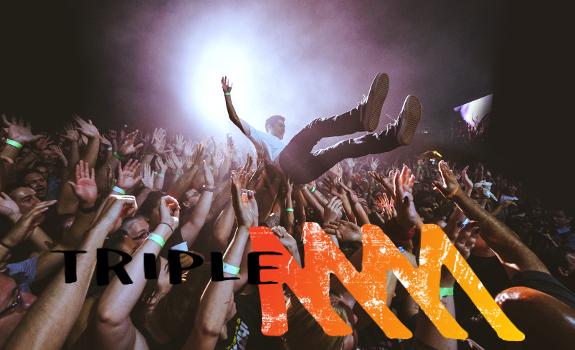
Like their male demographic, Triple M has evolved (image: Flickr / Do512, Southern Cross Austereo)
Create your own stationality
Triple M is a classic example of a heritage brand. Launched on August 1, 1980, it was the first FM station Down Under. For the first time, listeners could hear songs in stereo FM quality instead of a static AM sound. Fitzpatrick feels like they’ve got a close connection to the audience. “We ran a contest: Call Your Kid Triple M — and people did. That’s how much they cared about our brand.” During another stunt, the station got listeners to tattoo the brand logo on their body. The station has become famous for a unique blend of rock, sports and comedy, and for “the funniest morning show in Australia”.
Maintain your success formula
“One day, we ruined it. We went from playing rock music and having a funny morning show to playing Aqua next to AC/DC and killing our number 1 morning show. We didn’t really stand for anything anymore, and we had a new startup across the road called NOVA. They beat us at our own game. We went from an 11 share to a 3 share in four surveys. It is a textbook case of how to lose your audience.” His example makes clear how important it is to stay true to your brand values and your programming strategy when they’ve proven to be successful!
Get your swing back
It also shows that mistakes can be fixed. Rather than building a new brand, like NOVA’s smoothfm [case study] did more recently, Triple M chose to rebuild the existing one. “We started by looking at who our biggest fans were, and what was important to them”, Mike Fitzpatrick explains. They decided to stick to a few attributes. “We needed to focus on men. That hadn’t really been done before; radio stations in Australia and around the world had focused on demographics.” Instead, Triple M focused on psychographics (more on that in a moment).
“This is the face of the new masculinity”
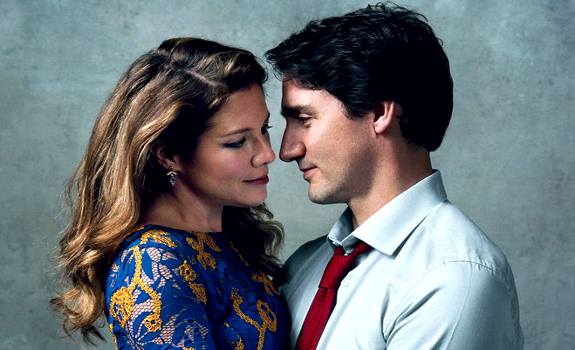
Canadian PM Justin Trudeau, here with his wife, represents the evolution of men (image: Vogue)
Establish your promotion strategy
Triple M produced a TV spot that didn’t speak much about their product, but would speak mainly about the listener:
“This was the insight we had into our audience ten years ago; this was what the Australian male, on average, wanted — this style of product, in this tone of voice.” He says that the campaign was successful on all editions of Triple M across the country, which all carry the same brand, but have different personalities on air. “We believe in localism; not networking.” The morning show, for example, is called The Grill Team on all editions, but every station has local talents hosting it.
Track your audience development
The campaign changed Triple M’s image and perception. “We became ‘Hugh Hefner’, who created a formidable brand. Men all over the world used to know the Playmates by name; a lot of us even read it for the articles. Now, most men in the world aren’t even aware there are Playmates left. Playboy failed to evolve with their readers.” Fitzpatrick thinks that The New Man is someone like Canadian prime minister Justin Trudeau. “He’s a sex symbol for women, and he’s the kind of bloke every man wants to be friends with. He’s a family man, a deep thinker, and a futurist, but he was also a boxer, he’s covered in tattoos, and he loves Rock music. He’s complex; he’s different. This is the face of the new masculinity.”
Research your audience attitudes
A recent market study has divided Australian men into 3 different categories based on their beliefs:
- (45%) Steadfast: fears real change; maintains traditional values
- (40%) Discover: is open minded; adjusts himself constantly
- (15%) Embrace: knows himself well; gender doesn’t matter
The station’s current audience still includes a lot of ‘steadfast’ men, who form about 45% of Australian males. “Our audience over-indexes with about 58%, so we’ve got a way to go.” They now gradually shift the station towards the trend that more men are open to evolve themselves, and therefore fall into the ‘discover’ category. Currently, 40% of men in Australia has that personality type, and they have role models like Justin Trudeau, who is in the remaining 15% ‘embrace’ group (in which Triple M currently under-indexes with only 5%). The station is working to expand their share where the most potential currently is — in the ‘discover’ group; in the middle!
“Our listener is not interested in the size of Kim Kardashian”
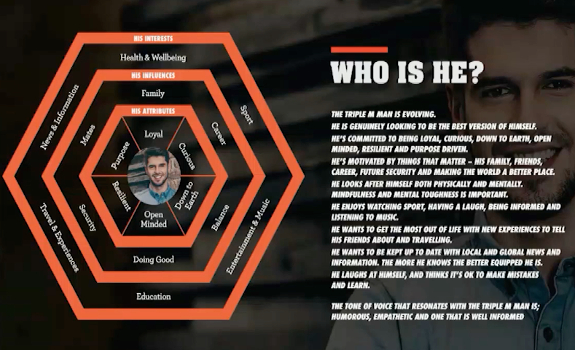
The Triple M HeHix defines the DNA of the station’s current core target audience (image: Triple M)
Visualise your model listener
Triple M went to describe the attributes, influences and interests of the desired core listener. Their model, which Mike Fitzpatrick calls HeHix, describes a man who is loyal, curious, down to earth, open minded, resilient, and purpose-driven. From those attributes, they defined influences (family, mates, career, security, balance and doing good) as well as interests (health & well-being, news & information, sports, travel & experiences, entertainment & music, and education). The Triple M target listener is ‘looking to be the best version of himself’ and ‘wants to get the most out of life’. He also ‘laughs at himself, and thinks it’s ok to make mistakes and learn’. The station’s tone of voice should be ‘humorous, empathetic, and well-informed’.
Update your brand values
While overall station proposition remains the same as it was ten years ago (rock, sports and comedy), the evolved attributes, influences and interests of the target audience make it possible to have a current stationality model. “We will use this as a filter to cast talent and create content. [Our listener] is not interested in the size of Kim Kardashian; we leave that for the female stations.” The station’s audience is, of course, more interested in things like sports, but they have to be presented by the right talent: “A lot of our sports broadcasters are ex-footballers. Ex-footballers kind of live in the stepfast category; not in the [discover] category, but there are some out there — so we’re hiring them.”
Differentiate your station tonality
Fitzpatrick defines 3 ways to create the right content for your audience, using your content filter:
1. Align with partners
Triple M collaborates with Movember Australia (promoting men’s health), White Ribbon (preventing domestic violence) and Black Dog (helping depressed men). In terms of sporting partnerships, they also make deliberate choices such as affiliating with Formula 1, but not the Ultimate Fighting Championship. Similar, they talk about women’s competitive football, rather than lingerie football, as that that wouldn’t be appropriate anymore.
2. Involve (your) talent
Inspired by a friend who’s committed suicide, Triple M Sydney radio personality Gus Worland has helped creating a video series about mental health called Men Up. Another initiative involves the Australian singer-songwriter Jimmy Barnes, who grew up in a world of domestic violence and alcohol abuse. In an episode of the video series Better Man, he’s portrayed as an example of a hard rocker who’s evolved towards the new masculinity.
3. Take a position
“Triple M has always worn its heart on its sleeve. We just need to change the tonality of how we do that”, the content director says. To make people notice the brand’s new attitude, the station deliberately stirred controversy, like with a subtle but clear statement on Australia Day. They chose the side of the country’s historic population by temporarily changing the Triple M logo colours into the those of the Aboriginal Flag.
“We punch up; not down”
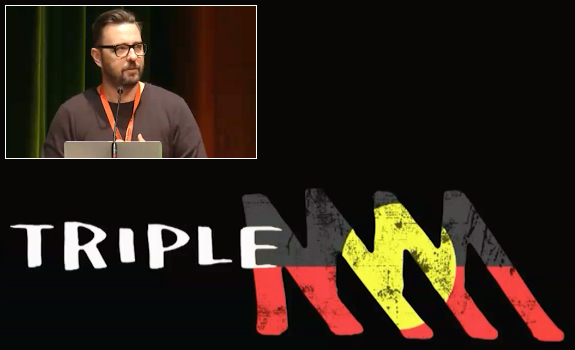
Triple M content director Mike Fitzpatrick says their station doesn’t shy away from addressing sensitive issues and debates (images: Radiodays Europe, Southern Cross Austereo)
Educate your talents & sponsors
Mike Fitzpatrick underlines the importance of education to make your strategy work. You want to tell your team how (and why) to create content that fits your brand values. Triple M has a mantra: “We punch up; not down. Our comedy is not belittling people; it’s self-deprecating or making fun of the establishment.” Last, but not least, you want to educate your marketplace: “They are aware of the shift in masculinity, but they wonder: how do I talk to that guy?” The station is doing roadshows to show media buyers how to reach The New Man, which, according to the content director, pays off. “Every key advertiser in Australia now knows: if you want to connect with men, you go to Triple M.”
Header image: Thomas Giger

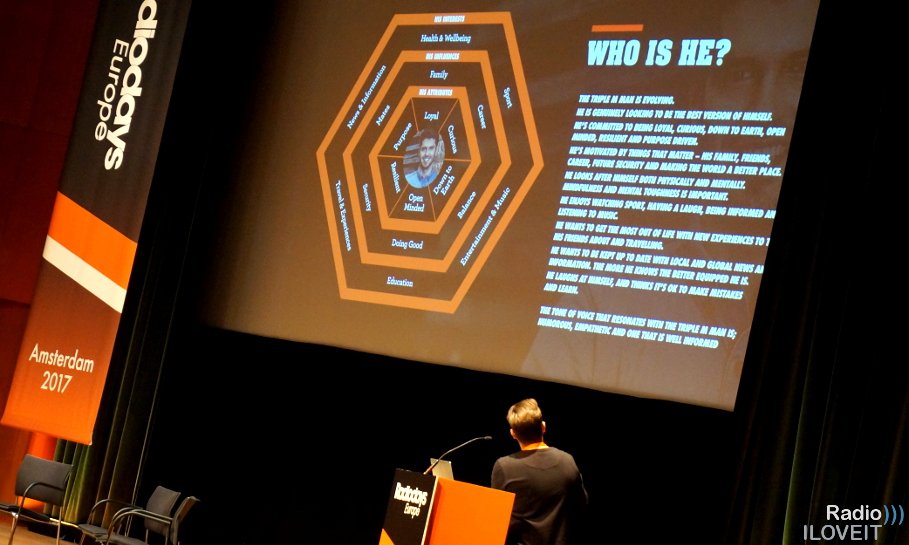




Add Your Comment